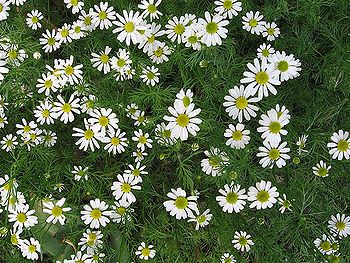Roman Chamomile
Other Names: Anthémis, Anthémis Odorante, Anthemis nobilis, Babuna Ke Phool, Camomille d’Anjou, Camomille Noble, Camomille Romaine, Chamaemelum nobile, Chamomilla, Chamomile, Chamomillae Ramane Flos, English Chamomile, Fleur de Camomille Romaine, Flores Anthemidis, Garden Chamomile, Grosse Kamille, Ground Apple, Huile Essentielle de Camomille Romaine, Low Chamomile, Manzanilla, Manzanilla Romana, Ormenis nobilis, Roman Chamomile Essential Oil, Romische Kamille, Sweet Chamomile, Whig Plant.
Roman Chamomile is a plant. The flowerheads are used to make medicine.
See also : German Chamomile.
Special Precautions of Roman Chamomile
- Roman chamomile seems safe for most people when taken by mouth as medicine and in foods. In large amounts, it can cause vomiting. It can also cause an allergic reaction in people sensitive to ragweed, marigolds, daisies, or similar herbs.
- The essential oil of Roman chamomile also seems to be safe when inhaled or applied to the skin.
- Pregnancy and breast-feeding: Roman chamomile is LIKELY UNSAFE when taken by mouth in medicinal amounts during pregnancy. Roman chamomile is believed to cause miscarriages. Not enough is known about the safety of applying it to the skin during pregnancy. Avoid using Roman chamomile if you are pregnant.
- It’s also best to avoid Roman chamomile if you are breast-feeding. Not enough is known about how it might affect the nursing infant.
- Allergy to ragweed and related plants: Roman chamomile may cause an allergic reaction in people who are sensitive to the Asteraceae/Compositae family. Members of this family include ragweed, chrysanthemums, marigolds, daisies, and many others. If you have allergies, be sure to check with your healthcare provider before taking Roman chamomile.
Benefits and uses of Roman Chamomile are
Roman chamomile contains chemicals that can help decrease gas (flatulence), relax muscles, and cause sedation. Depending on the dose, it can either relieve or cause nausea.
- used for various digestive disorders including indigestion, nausea, vomiting, loss of appetite, and intestinal gas (flatulence) due to mental stress.
- Women use it for morning sickness and painful menstrual periods. It is also used for pain and swelling of the lining of the nose and mouth, sinus pain (sinusitis), and joint (rheumatic) disorders.
- applied directly to the skin for pain and swelling (inflammation) and as a germ-killer in ointments, creams, and gels used to treat cracked nipples, sore gums, and irritation of the skin. It is also used topically for wounds, burns, eczema, frostbite, diaper rash, bedsores (decubitus ulcers), and hemorrhoids.
- Vasoconstrictor : Herbs Causing Constriction Of Capillaries
- sometimes mixed with other herbs and taken by mouth for liver and gallbladder disease, gallstones, fatty liver, chronic heartburn, loss of appetite, digestive disturbances, a heart condition called Roemheld's syndrome, indigestion in infants, and certain types of constipation. It is used as a "blood purifier" and general female tonic; and to prevent menstrual cramps and irregular periods.
- Some people put Roman chamomile in a steam bath and inhale it for sinus inflammation, hay fever, sore throat, and ear inflammation, and as a painkiller.
- Cancer : Apigenin is a flavonoid that binds to about 160 different proteins in the human body. The average chemo drug has trouble targeting just one damaged protein at a time. And a Japanese study points to a different substance in chamomile that can actually cause cancer cells to kill themselves. Called bisabolol oxide A (BSBO), this powerful compound gives chamomile its anti-inflammatory properties. Researchers found that it causes cancerous cells to shrink…within just 24 hours.
